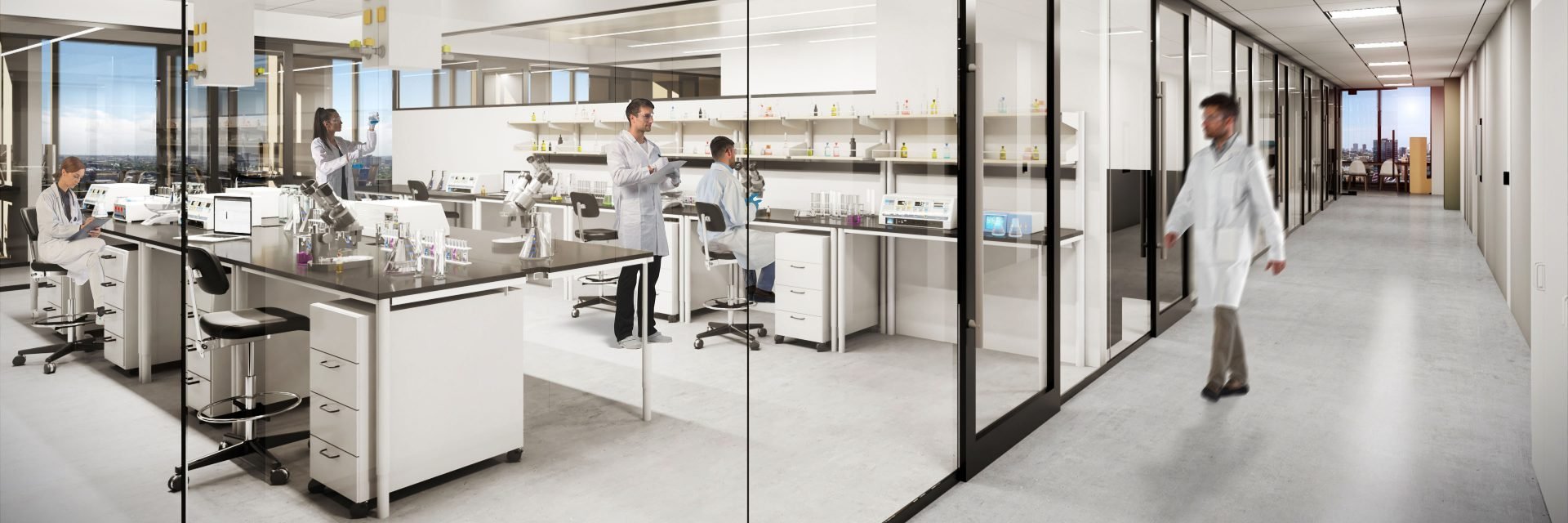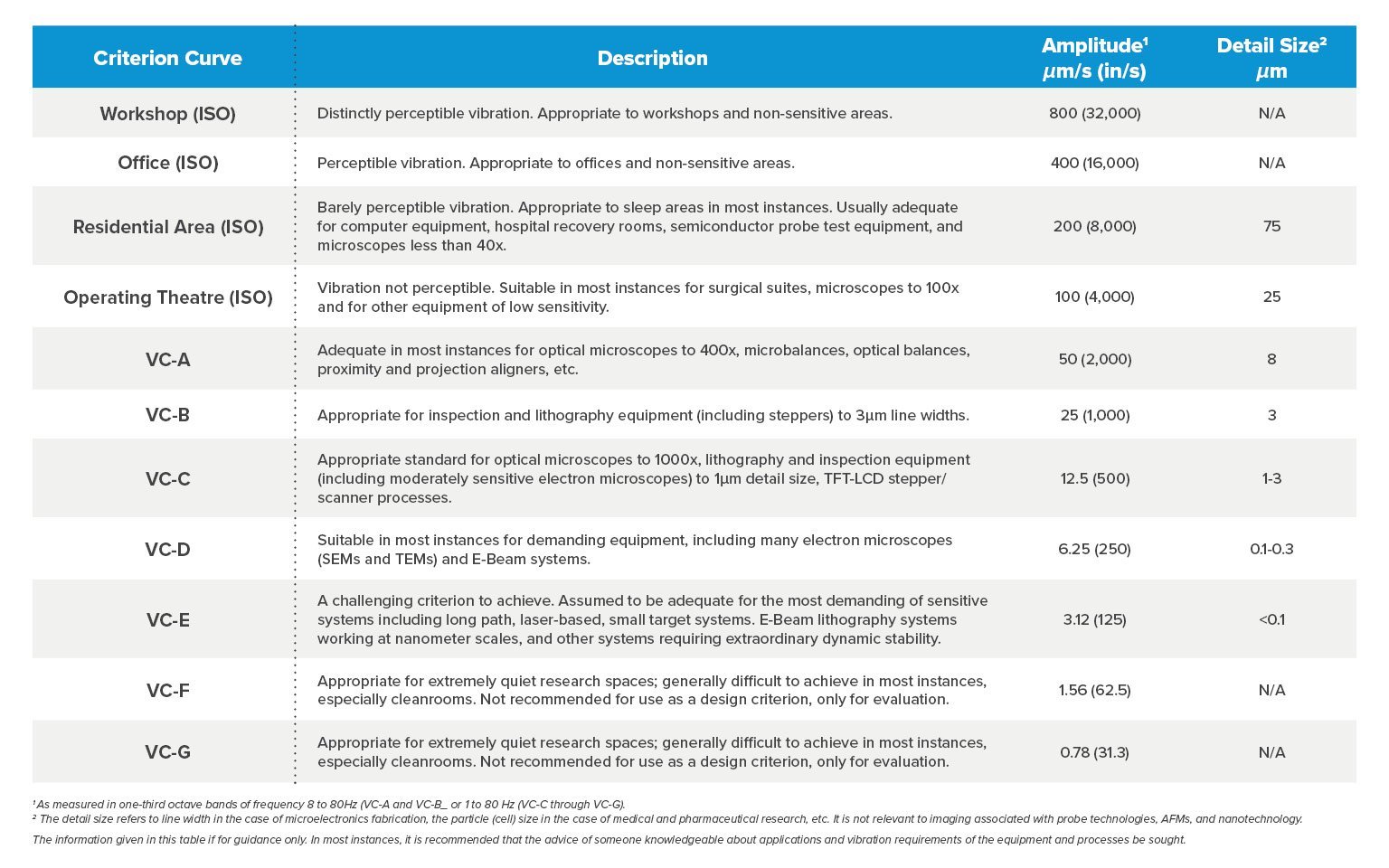
Lab planning and design, including lab vibration control, lays the foundation for efficient scientific work. It is the process of taking both basic program elements and highly technical blocks and arranging them to create a space that is safe and efficient.
It’s a balance of architecture and engineering that accounts for:
- Benching like work tables, casework, and adaptable systems with gases, power, and other utilities.
- Equipment that ranges from small weighing balances to large freezers, and highly technical robotics,
- Lab vibration control and how it affects lab equipment
- People which involves considering how to keep researchers and scientists safe in the most efficient and comfortable work environments.
Vibration and Equipment Planning
One major challenge with equipment planning is vibration control. Vibration within a lab poses a tremendous risk to millions of dollars of research effort. Many of us have felt vibrations in a building. For example, you may have been sitting quietly working away at your desk, and a group of employees walks by. You felt the subtle vibration of the group as they passed, and it may have distracted or stopped you from your work. This is similar to how vibration affects lab equipment. The vibration is transferred to the equipment changing the testing or processes, and even drastically affecting the outcomes.

Fulton Labs at 400 N. Aberdeen is the second building within Trammell Crow Company’s life and health sciences campus built in Fulton Market, Chicago, one of the most sought-after neighborhoods in the US. With 425,000 sq. ft. of newly constructed, next-generation wet/dry lab and office space—and incredible amenities, the 16-story building was designed to the highest possible laboratory standards. The floors are column-free and laid out to accommodate lab space as well as offices. The building includes a variety of amenities such as a gym, rooftop lounge, and balcony that overlooks the city skyline. Fulton Labs is the world-class science campus innovators deserve.
Given its location and the variety of scientific research taking place in the facility, vibration control in the lab areas became a crucial design consideration.
Vibration impacts come from a variety of sources, all of which were strategically designed and planned for at Fulton Labs:
- Vibration and noise from outside of the lab such as a train, airport, or roads.
- Vibration generated by other equipment in the building and lab such as an air handling unit or a lab centrifuge.
- Vibration from the floor caused by lab techs as they walk back and forth to complete their work. This is likely the most common issue we see and not apparent until it is too late to correct.
Outdoor conditions like movement from adjacent trains, airports or roads can impact the entire building. For example, if a site is located near a railroad, vibrational studies can determine the impact on the lab environment.
Internally, the vibration may be the result of mechanical equipment such as an air handling unit providing the lab HVAC. Elevators are often a source of vibration in a building, especially where there is more than one. Local sources from the lab equipment itself can very easily transfer through the floor. A lab centrifuge is a good example here. As one machine starts a cycle, it can vibrate enough to cause a problem or throw off values with another nearby. In extreme cases, vibration can damage equipment and even present a safety hazard. Even motion within a lab can be problematic. As technicians go-between machines, start and stop processes, or move samples they create vibrations that can affect the equipment. Typical vibration caused by foot traffic commonly occurs in the main corridor adjacent to the core and is caused when many people are walking at once.
In the early 1980s, Eric Ungar and Colin Gordon Developed Vibration Criteria (VC ) curves, originally as generic vibration criteria for sensitive equipment used in the semiconductor, medical and biopharmaceutical industries. Equipment operational problems that are caused by vibration, can be prevented if environmental vibration complies with the vibration criterion curves appropriate to the equipment-specific vibration criteria. Since then, the VC criteria have found application in a wide variety of technological applications (Figure 1).


Figure 1: Vibration Criterion Curves are used as a basic principle in designing labs facilities due to the sensitive nature of the equipment and research being conducted.
Today, new lab designs, like that created for Fulton Labs by CRB, use the VC-A level for vibration control. This criterion accounts for a majority of vibration impacts from lab equipment, buildings, and external factors. Equipment usually affected by vibration includes incubators, HPLCs, mass spectrometers, microscopes, and high-resolution microscopy, balances, 3D printers and bioprinters, liquid handlers, PCR machines, and analytical equipment. When the initial VC-A level is exceeded, special conditions may be applied to increase the capacity for vibration control. Usually, these are slab on grade conditions at the first floor with isolated floor slabs, or special sections of a column grid are structurally designed to enhance the vibration control to a much higher level. These are very specific instances and rarely apply to the whole building.
As the industry moves to increasingly toward compact robotic automation, vibration control is becoming a standard operating procedure. This is true in the design and construction of Fulton Labs. In general, there are three levels of robotic automation used in a lab – low, medium, and high.
- Today, low level of robotic automation is most likely incorporated into virtually every existing lab. This may be a small piece of equipment, perhaps no larger than a coffee machine, that automates one part of a repetitive part of a process, like extracting DNA from samples. Implementing even one low-level robotic automation frees the scientists from routine tasks allows them to use their time more effectively and increases productivity.
- In a lab with a medium amount of automation, you might see several processes in a contained box. This does not eliminate manual functions from the lab, but eliminates a few repetitious tasks by using equipment that addresses more than one step in the process.
- In labs with a high level of robotic automation, the entire room may be fully automated. This saves significant costs in the design and operation of a facility. For example, the lab design may not have to prioritize occupant comfort or safety so a more sustainable solution can be used. Ventilation rates and air changes may be reduced or not required, which in turn reduces the overall construction cost. In addition, by decreasing labor costs, reducing time spent by employees on repetitive tasks, and reallocating uses to higher-value activities companies bring safe and effective drugs to market in a shorter time and at a lower cost.
At Fulton Labs, the facility was designed to accommodate all levels of automation, including both wet and dry labs.
Unlike Fulton Labs, buildings not initially designed for lab use are unlikely to meet the vibration criteria. While there are solutions to address vibration in existing buildings, they come at a cost. The total investment should be balanced against the risk of research needs. Some of the solutions for existing sites include:
- Place the labs at the slab on grade level. This helps avoid vibration issues in labs and isolates them from issues in the rest of the structure. While it is typically the least expensive option, it does limit their location a single floor.
- Use air tables for the equipment. While this is a non-structural solution, it can require a much higher equipment budget.
- Complete structural upgrades with new connections or additional support. This may be the most expensive option, however, especially if the lab space is occupied.
- Strategically place equipment near structural columns and/or beams. This requires the structural engineer to make a heat map of VC-A zones in a plan so the equipment can be placed in the proper zones. While it addresses vibration, it may not be the ideal lab workflow.
Fulton Labs is one example of a growing trend to create life sciences hubs in the middle of thriving neighborhoods to attract and retain local biotech and pharmaceutical companies and emerging leaders. These vibrant and busy locations along with the sensitive equipment used in labs make vibration control a paramount design consideration for both new construction and established buildings. For new labs, following the VC-A requirement for vibration control will help protect not only life-saving research but the investment behind them.
Ready to start your next lab project? Our laboratory design experts are here to help.


